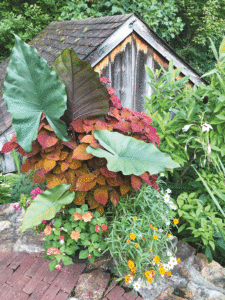
In Dr. Robert Lyons’ home garden, Phoenix Springs” having too much color doesn’t factor in. (Photo courtesy Dr. Robert Lyons)
If you visit the garden of Dr. Robert Lyons, professor emeritus at the University of Delaware, you might say it is too bright, too intense, even garish.
“Always, to color outside the lines,” he says. “If plants work together and grow, why not plant them together?”
A speaker at the recent Delaware Horticulture Industry Expo in Dover, Lyons has taught courses in herbaceous plants at Virginia Tech, North Carolina State University and the University of Delaware.
He co-founded and was director of the Virginia Tech Horticulture Gardens, was director of the J.C. Raulston Arboretum at N.C. State, and was program director for the Longwood Graduate Program.
Lyons readily shared that he had been diagnosed with Attention Deficit Disorder as a child, and views himself as “an attention deficit gardener.”
He eschewed the use of medication, he said, instead subjecting his family to many years of “bouncing off the walls.”
Among his own ADD behavioral traits are these: He is easily distracted.
He is easily bored and welcomes change. He seeks visual stimulation frequently.
In the garden, pruning leads Lyons to planting which leads to weeding, which leads to mulching.
“It’s a wonder I ever get anything accomplished. I often must retrace my steps to find a missing tool,” he confessed.
The urge to acquire plants is constant and often on the edge of hoarding. “How many of you have a driveway garden of pots of plants to be planted someday?” he asked. Many in the audience had to raise their hands.
“We don’t know where they’re going to go,” he said. “We buy plants and worry about where they will go later.”
Buying plants took precedence over other things that should have higher priority, including paying bills, he said.
“In grad school, I had no money, but I was always able to buy plants or obtain them from a friend,” he admitted.
By the same token, giving away plants may seem like an unselfish gesture, but it really means there is room in that driveway or garden for more.
“Back in the day, annuals had their own garden. Perennials went in another garden; houseplants stayed inside,” Lyons said, adding he always leaves space in his gardens for adding transient, seasonal color.
“If there’s a space, put in a container of color,” he suggested. “You can move them at whim. If you come three times to my garden, you’ll find something different every time.” That not only applies to containers but to plants that get moved to see if they’ll do better under different conditions.
He likes plants that self-sow or have seeds that are easily collected. He included Rudbeckia hirta (black-eyed Susan) and verbena. “A quick hoeing in the spring will take out unwanted plants,” he said. “Add marigolds in between.”
“I sequence sow sunflowers, so they are always there.”
Sunflowers (Helianthus annuus) self-sow, as do Jerusalem cherry (Solanum pseudocapsicum), pumpkin on a stick (Solanum integrifolium) and celosia. Jerusalem cherry, which used to be grown with poinsettias, fell out of favor because they’re toxic.
“Don’t parents still tell kids, ‘Just because you see a plant doesn’t mean you can eat it!’?” he asked.
He likes morning glory, too, because it’s “open today and gone tomorrow.”
He said he understands the objection to morning glory because it’s a heavy self-sower, but “there’s got to be a way to use them.”
He gets impatient with late-bloomers, but they eventually do come through with flowers. Salvia Rocketeer, for example, bursts into flower in September or October. Mexican sage (Salvia leucantha) is a great late bloomer. But it’s not a perennial here, Lyons warned. Pineapple sage (Salvia elegans) puts out red flowers late in season, a “last chance for hummingbirds.” He showed a photo of a plant that started as a 3-inch cutting and grew to 3 feet tall by 3 feet wide.
Other flowers have an extremely short flowering time, such as moon flower which has big white, fragrant flowers that open for one evening; four o’clocks that open late in the afternoon and are gone the next day; or daylilies, described as the consummate plant, perfect for “hell strip gardening” between sidewalk and street.
Lyons also likes vines and sprayer plants that “won’t stay still and take their color with them.” Rex begonia (Cissus discolor) is one of these, one of the few that thrives in full shade. Snail vine (Vigna caracalla) has a thick, heavy, sweet fragrance. Also known as corkscrew vine, it is not easy to grow from seed. Cup and saucer vine (Cobbaea scandens) has a cathedral bell-shaped flower. “I am comfortable letting vines meander through my garden without a structure to climb on,” he said.
Lyons found himself without a structure at all a few years ago when his house caught fire and exploded. He lost everything he owned, but built a new house and a new garden. His new place is called “Phoenix Springs.”
Before the fire, he had 50 containers in his garden. “I couldn’t tell the firemen to be careful,” he said.




